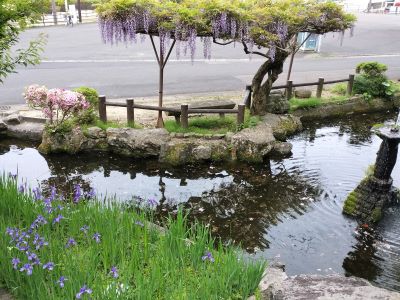
柿本人麻呂
What’s News
At the entrance to the Kakinomoto no Hitomaro Jinja, wisteria flowers and iris were blooming. You can enjoy the competition of flowers along with the azaleas.


Masuda City is said to be the place where Kakinomoto no Hitomaro, who is famous in the Manyoshu (Waka poetry), was posted and died (there are various theories). In the Manyoshu, there is a poem about Kamoyama, an island off the coast of Masuda, so it is one of the leading candidates as the place where Hitomaro was posted and died. In the Manyoshu, there are nearly 90 Choka (long poems) and Tanka (short poems) attributed to Hitomaro, who is revered as “the saint of Waka” and “the god of Waka.” There is Takatsu Kakinomoto no Hitomaro Shrine.
Throughout the country, Hitomaro is worshipped as the “god of poetry” in various statues. He is widely worshipped as the god of waka poetry, academic progress, fire prevention, and easy childbirth. The name “Hitomaro” is associated with the pronunciations “Hi-tomeru (Turn off the fire)” and “Hito-umaru (People are born),” and he is regarded by the common people as the god of fire prevention and safety.
It is widely popular among the people of Masuda, and is visited by many visitors during the New Year and the Hassaku Festival on September 1.














As it was 1300 years since Hitomaro’s death, various events were held in Masuda in 2023. Iwami Kagura and Kyogen were created and performed with Hitomaro as the motif.
Hitomaro is still a mysterious poet.

Access to Kakinomoto no Hitomaro Shrine
Take the Nijo line to’ Hitomaru shita’ (8 minutes) or the Lake Banryu line to’ Takatsu’ (7 minutes) and walk for 5 minutes.
Open all day
Free